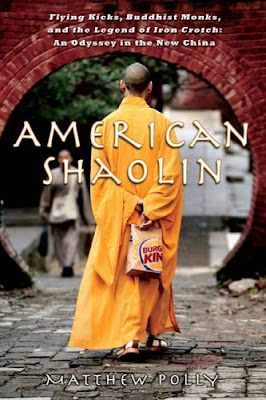
A few months back I spent an afternoon in New Haven, Connecticut talking to my English housemate, an ex MMA fighter, about his martial arts movie collection. After watching Never Back Down, an MMA-themed feature film, we headed down to the local pub. Later on that night we found ourselves chatting with a guy we just chanced to sit next to. He mentioned that he’d lived in China for two years at the Shaolin Temple. So, thinking it would be right up his alley, I asked him, “Have you read American Shaolin?” And he smilingly said, “Yeah, I wrote it!”.
Matthew Polly, the author of American Shaolin offered to do an exclusive interview for the Skritter audience:
Ben: One of the most memorable parts of American Shaolin was the section on iron crotch kung fu. Can you explain what the motivation is behind this technique? How many practitioners of iron crotch would you say there are world-wide?
Matt: All the Shaolin monks specialize in at least one iron kung fu. The idea is to harden (pun intended) a particular body part to make it impervious to pain or damage. It is something a number of martial arts, besides Shaolin, promote. For example, Thai kickboxers harden their shins. An iron head master can break bricks, an iron stomach can take a full kick to the gut, and an iron crotch master trains himself so he can take a full kick to the groin. Even by Shaolin standards it is considered a slightly weird practice. From what I know there are only a handful of masters who specialize in it.
Ben: I saw mention on your site of a trailer for the American Shaolin feature film. Can you tell us what is in the works with that?
Matt: Fox studios optioned the rights to the book and hired a screenwriter to adapt it. At present it is currently in turnaround. But I am hopeful that the story will eventually make it to the big screen.
Ben: When you arrived in China, what were some of the hardest parts about speaking Chinese?
Matt: I had taken four years of Chinese while at Princeton, but it is a very difficult language to learn. The hardest part for me was that I was basically at a grade-school level. So I was unable at first to express myself as I was used to in English, and Chinese people I met had to “talk down” to me, so I could understand what they were saying. The other difficulty is that while Mandarin is the government-approved version of Chinese, there are a number of different dialects spoken in China, like Cantonese and Shanghai dialect. Even in northern China where Mandarin is dominant, people often speak with thick, almost impenetrable, accents, especially in the rural parts of the country. And so it took time to adapt and comprehend what people were saying.
Ben: Did you work at all on your written Chinese during your stay at the Shaolin Temple? Were there any situations you found yourself in where you had to write Chinese characters?
Matt: I did not work on my written Chinese. Most of Chinese I spent time with in rural China were functionally illiterate. So knowing characters didn’t help. Also there is a division in the Chinese language between the simplified system used by the People’s Republic and the more complex characters, used in Taiwan, that I was taught in school. So over time, I became much better at speaking but much worse at reading and writing.
Ben: What have you been up to since publishing American Shaolin?
Matt: I have currently been working on a book about MMA, cagefighting, and The Ultimate Fighting Championship (UFC). Given my background in Shaolin kung fu, the idea was to explore and participate in MMA. I managed to survive and the book should be coming out next year.
Ben: I saw this youtube clip of you fighting David Cexton. Can you describe your MMA fighting career?
Matt: I spent two years training with some of the best MMA instructors in the world: John Danaher at Renzo Gracie Academy, Phil Nurse at the Wat, Joey Varner at Xtreme Couture. The goal was to scrape off the ring rust and prepare me for an MMA fight. At the end of the process, fortune smiled and I was able to win my bout against my opponent, David Cexton. It was a good fight. He nearly knocked me out a couple of times, but I was able to put my training to good use and came out victorious. He was 23-years-old; I was 38. Sometimes an old dog can learn new tricks.

Here are a few more youtube clips about Matt. The first one is footage from his days at the Shaolin Temple. The second clip is from a photoshoot where Matt wanted to capture a shot of himself while getting punched in the face. For those of you interested you could pick up some
iron crotch merchandise on
Matt’s homepage.
![]()
 Here are a few more youtube clips about Matt. The first one is footage from his days at the Shaolin Temple. The second clip is from a photoshoot where Matt wanted to capture a shot of himself while getting punched in the face. For those of you interested you could pick up some iron crotch merchandise on Matt’s homepage.
Here are a few more youtube clips about Matt. The first one is footage from his days at the Shaolin Temple. The second clip is from a photoshoot where Matt wanted to capture a shot of himself while getting punched in the face. For those of you interested you could pick up some iron crotch merchandise on Matt’s homepage.

